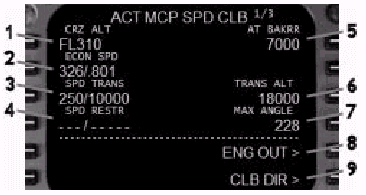
FOR FLIGHT SIMULATOR USE ONLY. NOT FOR USE
IN REAL AVIATION. Level-D Simulations 767-300...........Page
102
FLIGHT MANAGEMENT SYSTEM (FMS)
| 亙亙TOP儁乕僕 | 亙Level-D 767 儊僯儏乕 | 亙儅僯儏傾儖栚師 | 亙慜偺儁乕僕 | 亜師偺儁乕僕傊 |
僶乕僥傿僇儖(悅捈曽岦偺)僫價僎乕僔儑儞(VNAV)
忋徃丄弰峲丄崀壓偼FMC偺VNAV偲AFDS偺VNAV婡擻傪巊梡偡傞偙偲偱帺摦憖廲偝傟傑偡丅
PERF INIT儁乕僕偵擖椡偝傟偨僨乕僞偑丄FMC偵傛偭偰峲嬻婡偺悅捈曽岦偺惈擻寁嶼偵巊梡偝傟傑偡丅
LEGS儁乕僕偺忋徃偲弰峲偺梊應抣偼偙偺忣曬偐傜堷偒弌偝傟傑偡丅
傾儔僀僶儖丄傾僾儘乕僠偺堊偵丄LEGS儁乕僕偵僂僄僀億僀儞僩偺崀壓惂尷偑僾儘僌儔儉偝傟偨帪偼丄FMC偼崀壓僷僗傪寁嶼偟丄LEGS儁乕僕忋偵崀壓偺梊應抣傪摨條偵惗惉偟傑偡丅
CDU偺VNAV僼傽儞僋僔儑儞僉乕傪墴偡偲丄傾僋僥傿僽側VNAV儁乕僕偑昞帵偝傟傑偡丅
忋徃丄弰峲丄崀壓偺僙僌儊儞僩偵懳偟偰3偮偺VNAV儁乕僕偑棙梡壜擻偱偡丅
傾僋僥傿僽儁乕僕偼僼儔僀僩偺僼僃乕僘偵墳偠偰寛傔傜傟傑偡丅
僩僢僾丒僆僽丒僋儔僀儉(T/C)埲慜偼丄VNAV僉乕傪墴偡偲VNAV
CLB儁乕僕偑昞帵偝傟傑偡丅
T/C偲僩僢僾丒僆僽丒僨傿僙儞僩(T/D)偺娫偼VNAV僉乕傪墴偡偲VNAV
CRZ儁乕僕偑昞帵偝傟傑偡丅
T/D傪夁偓偰VNAV僉乕傪墴偡偲丄VNAV DES儁乕僕偑昞帵偝傟傑偡丅
NEXT偲PREV僉乕傪墴偡偙偲偱丄偄偮偱傕慡偰偺儁乕僕傪尒傞偙偲偑弌棃傑偡丅
VNAV偑傾僋僥傿僽側AFDS儌乕僪偺偲偒偼丄EADI忋偵VNAV
SPD偐丄VNAV丂PTH偲昞帵偝傟傑偡丅
VNAV SPD儌乕僪偲偼丄峲嬻婡偺懳婥懍搙偑峲嬻婡偺僺僢僠偱堐帩偝傟偰偄傞偙偲傪帵偟傑偡丅
偙偺儌乕僪偼VNAV僋儔僀儉偲VNAV僨傿僙儞僩偱僄儞僎乕僕偝傟傑偡(僗僺乕僪丒僀儞僞乕儀儞僔儑儞丒儌乕僪拞偵)
VNAV PTH儌乕僪偼峲嬻婡偺懳婥懍搙偑僗儔僗僩偱堐帩偝傟傞偙偲傪帵偟傑偡丅
偙偺儌乕僪偼慡偰偺VNAV丒儗儀儖僆僼偲丄VNAV僷僗丒僨傿僙儞僩拞偵僄儞僎乕僕偝傟傑偡丅
VNAV忋徃
VNAV CLB儁乕僕偲LEGS儁乕僕偵擖椡偝傟偨僨乕僞偵婎偯偒丄FMC偼VNAV忋徃僾儘僼傽僀儖傪宍惉偟傑偡丅
棧棨屻偵VNAV MCP儃僞儞傪墴偡偙偲偱VNAV偑僄儞僎乕僕偝傟傑偡丅
VNAV偑僄儞僎乕僕偝傟傞偲丄FMC偼僙僢僩偝傟偨惂尷懍搙傑偱壛懍偡傞傛偆偵巜帵偟傑偡丅
FMC偼TAKEOFF REFF儁乕僕偱僾儘僌儔儉偝傟偨壛懍崅搙(弶婜抣偼1000ft)偵払偡傞傑偱丄棧棨懍搙傪堐帩偟傑偡丅
FMC偼師偵丄嵟弶偺惂尷懍搙偱偁傞僼儔僢僾奿擺偺懍搙惂尷傑偱壛懍偡傞傛偆偵巜帵偟傑偡丅
僼儔僢僾傾僢僾屻偼丄弶婜偺栚昗懍搙偱偁傞250Kt偐丄傛傝掅偄LEGS儁乕僕偺SID僂僄僀億僀儞僩惂尷懍搙偵側傝傑偡丅
10,000ft(弶婜抣)傪捠夁偡傞偲丄栚昗懳婥懍搙偼FMC偑僙僢僩偡傞宱嵪忋徃懍搙偐丄儅僯儏傾儖僙僢僩偝傟偨忋徃懍搙偵側傝傑偡丅
宱嵪忋徃懍搙偼丄PERF INIT儁乕僕偱擖椡偝傟偨僐僗僩僀儞僨僢僋僗偵婎偯偒傑偡丅
慡偰偺VNAV忋徃偼VNAV SPD儌乕僪偱幚峴偝傟傑偡丅FMC偼TRP偑寛傔傞棙梡壜擻側嵟戝偺弌椡偱偺懳婥懍搙傪巜帵偟傑偡丅
VNAV偑僄儞僎乕僕偝傟偰偄傞応崌丄TRP偼棧棨屻帺摦揑偵CLB儌乕僪偵擖傝傑偡丅
僋儔僀儉丒僙僌儊儞僩偼FMC偑僾儘僌儔儉偟偨弰峲崅搙偵払偡傞傑偱懕偒傑偡丅
忋徃拞偺拞娫偱儗儀儖僆僼偡傞偙偲偼擇捠傝偺曽朄偱敪惗偟傑偡丗LEGS儁乕僕偺SID偺堦晹暘偱偁傞崅搙惂尷偵払偡傞偐丄FMC弰峲崅搙傛傝傕掅偔僙僢僩偝傟偨AFDS
MCP ALT偵払偡傞偐偱偡丅
LEGS儁乕僕偺崅搙惂尷偵憳嬾偟偨応崌丄儗儀儖僆僼偺堊偵丄VNAV
PTH儌乕僪偑僄儞僎乕僕偝傟傑偡丅
峲嬻婡偼崅搙惂尷偝傟偨僂僄僀億僀儞僩傪捠夁偟丄惂尷偑僉儍儞僙儖偝傟傞傑偱悈暯旘峴傪宲懕偟傑偡丅
師偵VNAV SPD儌乕僪偱忋徃傪宲懕偟丄FMC弰峲崅搙偵岦偐偄傑偡丅
FMC弰峲崅搙傛傝傕掅偔僙僢僩偝傟偨MCP ALT偵払偟偨応崌丄AFDS
ALT HOLD儌乕僪偑僄儞僎乕僕偝傟丄懍搙僐儞僩儘乕儖偼MCP偵栠偝傟傑偡丅
VNAV忋徃傪宲懕偡傞偨傔偵偼丄MCP ALT傪傛傝崅偄崅搙偵嵞搙愝掕偟丄VNAV
MCP儃僞儞傪墴偟偰VNAV傪嵞搙僄儞僎乕僕偟側偗傟偽側傝傑偣傫丅
忋徃拞偵堦帪揑側懍搙偺曄峏偑昁梫偲側偭偨応崌偼丄AFDS
MCP忋偵偁傞"僗僺乕僪丒僀儞僞乕儀儞僔儑儞"儌乕僪傪巊梡偟傑偡丅
懳婥懍搙慖戰僲僽傪墴偡偲丄MCP忋偺懳婥懍搙憢偑奐偒傑偡丅
VNAV忋徃懍搙偼MCP偺抣偵僙僢僩偝傟傑偡丅
師偵懳婥懍搙慖戰偺僲僽傪墴偡偲丄僗僺乕僪僀儞僞乕儀儞僔儑儞儌乕僪偑僉儍儞僙儖偝傟丄懍搙僐儞僩儘乕儖偑FMC偵栠偝傟傑偡丅
FMC弰峲崅搙偵払偡傞偲僩僢僾丒僆僽丒僋儔僀儉(T/C)偲側傝傑偡丅
梊應偝傟偨"T/C"傪帵偡偨傔偵丄傾僋僥傿僽儖乕僩忋偵"T/C"僔儞儃儖偑昞帵偝傟傑偡丅
T/C偵払偡傞偲峲嬻婡偼VNAV PTH儌乕僪偱儗儀儖僆僼偟丄VNAV弰峲儁乕僕偑傾僋僥傿僽側VNAV儁乕僕偲側傝傑偡丅
VNAV弰峲
峲嬻婡偑FMC偺僾儘僌儔儉偝傟偨僋儖乕僘崅搙偱儗儀儖僆僼偡傞偲偒丄VNAV
PTH儌乕僪偑僄儞僎乕僕偝傟丄VNAV憖嶌偺僐儞僩儘乕儖偼帺摦揑偵愗傝懼傢傝傑偡丅
When the FMC cruise altitude matches the
AFDS MCP ALT, VNAV PTH mode takes priority.
This is the reason that ALT HOLD mode does
not engage in this situation.
The default cruise airspeed set by the FMC
is the economy airspeed based on the cost
index entered on the PERF INIT page.
The cruise speed can be changed by manually
entering a new airspeed in the cruise page,
or by selecting long range cruise via the
"LRP>" prompt on the cruise
page.
Temporary airspeed changes can be handled
using speed intervention mode as described
previously.
Once the VNAV cruise altitude is reached,
altitude changes during the cruise segment
of the flight are handled in cruise climb
or descent mode.
This mode is entered when a new cruise altitude
is entered in the FMC and the AFDS MCP ALT
is set to match.
The aircraft climbs or descends to the newly
selected altitude using VNAV SPD mode.
When the MCP ALT is initially set to a different
altitude, the AFDS remains in the VNAV PTH
mode until the FMC cruise altitude is set
to match.
Also, if the FMC cruise altitude is set to
a different value and the MCP ALT remains
the same, the aircraft remains level in VNAV
PTH until the MCP ALT is set to match.
Temporary airspeed changes needed during
the cruise can be handled using the "speed
intervention" mode on the AFDS MCP.
Pressing the airspeed select knob opens up
the airspeed window on the MCP.
The VNAV cruise airspeed is now set by the
MCP value.
Pressing the airspeed select knob a second
time cancels speed intervention mode and
transfers speed control back to the FMC.
The cruise phase continues until reaching
the top-of-descent (T/D) point.
This point denotes when a descent for approach
and landing begins.
The T/D is calculated by the FMC based on
arrival waypoint altitude constraints set
on the LEGS page.
A "T/D" symbol is shown along the
active route to denote the predicted top-of-descent
point.
When the T/D is reached, the VNAV DES page
becomes the active VNAV page.
VNAV DESCENT
The initial VNAV descent path is calculated
from the T/D to the first waypoint altitude
constraint on the LEGS page.
The initial path is calculated for IDLE thrust
using the airspeed set in the VNAV DES page.
All subsequent descents are calculated as
straight line descents between LEGS page
altitude constraints at the selected speed
and required thrust.
The descent is accomplished in VNAV PTH mode.
In order for the aircraft to begin an automatic
descent upon reaching the T/D, the MCP ALT
must be set to a lower altitude.
If the aircraft reaches the T/D and the altitude
has not been reset, the AFDS enters ALT HOLD
mode.
To restore VNAV control over the descent,
a lower altitude must be selected on the
MCP and the AFDS VNAV button must be pressed.
The default descent airspeed set by the FMC
is the economy airspeed based on the cost
index entered on the PERF INIT page.
The descent airspeed can be changed by manually
entering a new airspeed on the descent page.
The descent speed is also changed by setting
waypoint airspeed constraints on the LEGS
page.
When a waypoint is encountered that has an
airspeed constraint, the DES page airspeed
is changed to this new value.
Temporary airspeed changes can be handled
using speed intervention mode as described
previously.
A descent in speed intervention mode changes
the active VNAV mode from VNAV PTH to VNAV
SPD.
The descent to the first altitude restriction
is accomplished at idle thrust.
When the throttle reaches idle during descent,
the A/T enters THR HOLD mode.
Descent airspeed is monitored by the FMC
to maintain +/- 15 knots of the commanded
airspeed while on the descent path.
If the airspeed exceeds the set speed by
more than 15 knots, a "DRAG REQUIRED"
message is generated in the FMC scratchpad.
This indicates that speed brakes are required
to slow the aircraft down.
If the airspeed is below the set speed by
more than 15 knots, the A/T re-engages in
the SPD mode to add power.
Intermediate level offs during descent can
occur in two ways: reaching a LEGS page altitude
constraint on a STAR/Approach, or encountering
an AFDS MCP ALT set higher than the FMC altitude
constraints.
When a LEGS page altitude constraint is encountered
that requires a level off, the VNAV PTH mode
remains engaged for the level off.
The aircraft remains level until reaching
the last waypoint having the same altitude
restriction, at which point the VNAV PTH
descent continues to the next altitude constraint.
If the MCP ALT is set higher than the altitude
constraints in the LEGS page, the AFDS enters
ALT HOLD mode when the MCP altitude is reached.
To continue a VNAV descent, the MCP ALT must
be reset to a lower value and the AFDS VNAV
button must be pressed.
After the T/D is reached, the EHSI displays
a Vertical Track Indicator (VTI) on the right
side of the display.
The VTI pointer indicates if the aircraft
is high or low on the VNAV descent path.
The pointers range is +/- 400 feet.
Progress page 2 also has a VTK ERROR line
that displays the exact vertical track error
in feet.
Temporary airspeed changes needed during
the descent can be handled using the "speed
intervention" mode on the AFDS MCP.
Pressing the airspeed select knob opens up
the airspeed window on the MCP.
The VNAV descent airspeed is now set by the
MCP value.
Pressing the airspeed select knob a second
time cancels speed intervention mode and
transfers speed control back to the FMC.
The descent phase continues until reaching
the end of descent at the destination airport.
The end of descent is normally the runway
selected for approach.
If a runway is not selected, the E/D is the
last waypoint on the LEGS page that has an
altitude constraint.
VNAV Pages (CLB, CRZ, DES)
Pressing the VNAV function key on the FMC
CDU displays the active VNAV page.
The available pages are climb (CLB), cruise
(CRZ) and descent (DES).
The page displayed when the VNAV function
key is pressed is dependant on the phase
of flight.
All three pages may be viewed at any time
by using the NEXT and PREV PAGE function
keys.
VNAV CLB Page
The VNAV CLB page is primarily used during
the climb segment to control airspeed when
VNAV is in use.
The title of the VNAV CLB page indicates
if the data displayed is active (ACT) or
modified (MOD).
Additionally, if the AFDS is in speed intervention
mode, the title changes to "MCP SPD
CLB" to indicate that speed is controlled
via the MCP.
All modifications to CLB page data require
execution with the EXEC function key prior
to becoming active.
When modifications are made, an "<ERASE"
prompt appears at the 6L LSK.
Pressing the 6L LSK prior to executing the
changes erases all changed data and restores
the display of active data.
For VNAV to function, a CRZ ALT is required.
All other data boxes are either optional
or display default FMC data.

1- Cruise Altitude: The cruise altitude entered on the PERF
INIT page is displayed here.
To change the target cruise altitude, enter
an altitude into the scratchpad followed
by pressing the 1L LSK.
Valid entries for altitude are XXX, XXXX,
XXXXX, and FLXXX.
The altitude is displayed in feet when below
the TRANS ALT and as flight levels when above.
Changes to the cruise altitude on this page
are carried over to all other pages that
display CRZ ALT.
2- Speed Display: Displays the current target climb airspeed/Mach.
ECON SPD is displayed when economy speed
is in use.
SEL SPD is dispayed when a speed is manually
entered.
To change the current climb speed, type an
IAS or MACH speed into the scratchpad and
press the 2L LSK.
If the entry of both speeds is desired, the
format is xxx/.XXX, where xxx is IAS and
.XXX is MACH.
The FMC commanded airspeed is IAS until the
MACH value is reached.
To restore ECON speed when SEL SPD is displayed,
press the DEL data entry key followed by
the 2L LSK.
If speed intervention mode is in use, the
title page changes to "MCP SPD CLB".
In this mode, airspeed is controlled via
the MCP and cannot be controlled on the VNAV
CLB page.
3- Speed Transition: Displays the FMC transition airspeed and
altitude.
The FMC target climb airspeed is limited
to the value displayed until reaching the
altitude displayed.
The airspeed limit is removed as the aircraft
climbs through the altitude displayed.
The default value is 250 knots until reaching
10,000 feet.
This entry may be changed or deleted manually.
To change the entry, type xxx/XXXXX (xxx=airspeed,
XXXXX=altitude) into the scratchpad and press
the 3L LSK.
To delete the entry, press the DEL data entry
key followed by the 3L LSK.
4- Speed Restriction: This is an optional field for the entry
of an additional FMC climb speed restriction
to altitude.
To make an entry, type xxx/XXXXX (xxx=airspeed,
XXXXX=altitude) and press the 4L LSK.
When an entry is made, the FMC target airspeed
is limited to the value displayed until reaching
the altitude displayed.
To delete the speed restriction, press the
DEL data entry key followed by the 3L LSK.
5- Waypoint Altitude Constraint: Displays the next waypoint altitude constraint
entered into the LEGS page.
If no altitude constraints are entered into
the LEGS page, this field is blank.
When VNAV is engaged, the FMC commanded airspeed
and altitude are constrained to the values
entered on the LEGS page until reaching the
displayed waypoint (AT XXXXX).
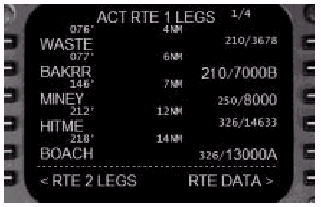
Consider the following example of how VNAV
climb is managed with waypoint constraints.
Airspeed and altitude climb constraints are
entered onto the LEGS page in the right column
of the waypoint data line.
Data displayed in small type are speed and
altitude predictions based on performance.
Data displayed in large type are speed and
altitude constraints.
The constraints are entered manually or by
procedure.
See the LEGS Page section of this manual
for an explanation of how to enter manual
speed and altitude constraints.
The example LEGS page shows that a speed
and altitude constraint of 210/7000B has
been entered at the BAKRR waypoint.
The FMC restricts the commanded VNAV speed
to 210 knots until BAKRR (notice that the
airspeed prediction for WASTE is 210).
The FMC also restricts the VNAV climb to
cross BAKRR at or below 7000 feet.
After passing BAKRR, the VNAV CLB page changes
to "AT MINEY" and "8000"
since the MINEY waypoint has an altitude
constraint of 8000 feet.
The MINEY waypoint is not speed restricted
since the airspeed is displayed as 250 in
small type.
Therefore, after passing the BAKRR waypoint,
VNAV continues a climb to 8000 feet at 250
knots.
After passing MINEY, The VNAV CLB page changes
to "AT BOACH" and "13000"
since the BOACH waypoint has an altitude
constraint of 13000 feet or above.
The BOACH waypoint is not speed restricted
since the speed is displayed in small type.
Notice that the speed prediction is now 326
since the FMC airspeed in this example is
no longer restricted to 250/10000 (the entry
in the SPD TRANS data line on the VNAV CLB
page).
Keep in mind that for a VNAV climb to continue
at each waypoint, the MCP ALT must be set
to a higher altitude than that listed for
a LEGS page constraint.
If the MCP ALT is reached prior to a LEGS
page constraint, the AFDS levels off in ALT
HOLD mode.
In this case, the MCP must be reset to a
higher altitude and VNAV reselected on the
MCP for a VNAV climb to continue.
6- Transition Altitude: Displays the altitude above which the FMC
begins to list altitudes as flight levels.
This value may be manually changed by typing
an altitude into the scratchpad followed
by pressing the 3R LSK.
7- Maximum Angle Speed: Displays the maximum angle of climb speed
based on performance calculations.
This speed is for reference only and cannot
be changed.
8- Engine Out Speed Prompt: When pressed, changes the page to display
engine out data.
9- Climb Direct Prompt: When pressed, removes all speed and altitude
climb constraints entered into the LEGS page.
If VNAV is in use, the FMC continues to climb
until reaching the CRZ ALT or the MCP ALT,
whichever is lower.
VNAV CRZ Page
The VNAV CRZ page is used to control airspeed
and altitude while in the cruise phase with
VNAV engaged.
All airspeed and altitude changes are made
from this page only.
Cruise speed and altitude changes are never
made via the LEGS pages.
The title of the VNAV CRZ page indicates
if the data displayed is active (ACT) or
modified (MOD).
The title page changes to indicate the cruise
speed selected as follows:
All modifications to CRZ page data require
execution with the EXEC function key prior
to becoming active.
When modifications are made, an "<ERASE"
prompt appears at the 6L LSK.
Pressing the 6L LSK prior to executing the
changes erases all changed data and restores
the display of active data.
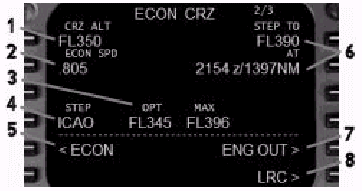
1- Cruise Altitude: The cruise altitude entered on the PERF
INIT page is displayed here.
To change the cruise altitude, enter an altitude
into the scratchpad followed by pressing
the 1L LSK.
Valid entries for altitude are XXX, XXXX,
XXXXX, and FLXXX.
The altitude is displayed in feet when below
the TRANS ALT and as flight levels when above.
Changes to the cruise altitude on this page
are carried over to all other pages that
display CRZ ALT.
After reaching the cruise altitude in VNAV,
all enroute changes in altitude prior to
the T/D are initiated by changing the cruise
altitude on the CRZ page.
Type the new cruise altitude into the scratchpad
and press the 1L LSK to change the CRZ ALT.
Then, select the new target altitude on the
AFDS MCP.
This initiates a VNAV cruise climb or descent
to the new altitude.
If both altitudes (FMC and MCP) are not changed,
VNAV continues in cruise at the previously
programmed altitude.
2- Speed Display: Displays the current target cruise speed.
ECON SPD is displayed when economy speed
is in use.
SEL SPD is displayed when a speed is manually
entered.
LRC SPD is displayed when long range cruise
is selected.
E/O SPD is displayed when the engine out
speed is selected.
To change the current cruise speed, type
an IAS or MACH speed into the scratchpad
and press the 2L LSK.
The format is XXX for IAS and .XXX for MACH.
To restore ECON speed when SEL SPD is displayed,
press the "<ECON" prompt at
the 5L LSK.
If speed intervention mode is in use, the
title page changes to "MCP SPD CRZ".
In this mode, airspeed is controlled via
the MCP and cannot be controlled on the VNAV
CRZ page.
3- Optimum and Maximum Altitudes: Displays the optimum and maximum cruise
altitudes for the aircrafts current gross
weight based on FMC performance data.
4- Step Size: Displays the step climb value used for VNAV
STEP TO performance calculations.
ICAO is the standard value and indicates
a step climb size of 2000 feet below FL290
and 4000 feet above FL290.
Valid entries range from 0 to 9000 in 1000
foot increments.
When "0" is entered, all VNAV predictions
are based on a constant cruise altitude.
5- ECON Prompt: Press the 5L LSK to change the speed display
to economy speed.
6- Step Data: The STEP TO field displays the recommended
step climb altitude based on the step size.
The AT field displays the point at which
a step climb is recommended.
In this example, a step climb is not recommended
until 1397 miles which is predicted to occur
at 2154Z time.
7- Engine Out Prompt: Press the 5R LSK to select the engine out
speed.
8- Long Range Cruise Prompt: Press the 6R LSK to select the long range
cruise speed.
VNAV DES Page
The VNAV DES page is used to make modifications
to the descent path.
This page is primarily used to make VNAV
descent airspeed modifications.
The title of the VNAV DES page indicates
if the data displayed is active (ACT) or
modified (MOD).
Additionally, if the AFDS is in speed intervention
mode, the title changes to "MCP SPD
DES" to indicate that speed is controlled
via the MCP.
If a specific descent airspeed or Mach has
been entered, the page title changes to reflect
the manually entered speed.
All modifications to DES page data require
execution with the EXEC function key prior
to becoming active.
When modifications are made, an "<ERASE"
prompt appears at the 6L LSK.
Pressing the 6L LSK prior to executing the
changes erases all changed data and restores
the display of active data.
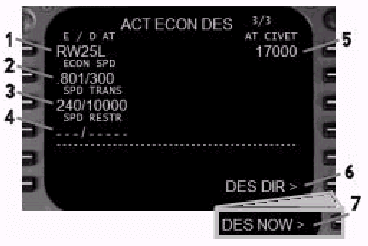
1- End of Descent Waypoint: Displays the name of the waypoint in the
LEGS page with the lowest altitude constraint.
This field is blank if no altitude constraints
have been entered on the LEGS page.
2- Speed Display: Displays the current target descent airspeed/Mach.
This airspeed is used to calculate the VNAV
descent path.
This speed is commanded by the FMC during
the descent until a lower speed is encountered
as part of a LEGS page constraint.
ECON SPD is displayed when economy speed
is in use.
SEL SPD is displayed when a speed is manually
entered.
To change the current descent speed, type
an IAS or MACH speed into the scratchpad
and press the 2L LSK.
If the entry of both speeds is desired, the
format is .XXX/xxx, where XXX is MACH and
xxx is IAS.
The FMC commanded descent airspeed is MACH
until the IAS value is reached.
To restore ECON speed when SEL SPD is displayed,
press the DEL data entry key followed by
the 2L LSK.
If speed intervention mode is in use, the
title page changes to "MCP SPD DES".
In this mode, airspeed is controlled via
the MCP and cannot be controlled on the VNAV
DES page.
3- Speed Transition: Displays the FMC transition airspeed and
altitude.
The FMC target descent airspeed is limited
to the value displayed at or below the altitude
displayed.
The default value is 240 knots at or below
10,000 feet.
This entry may be changed or deleted manually.
To change the entry, type xxx/XXXXX (xxx=airspeed,
XXXXX=altitude) into the scratchpad and press
the 3L LSK.
To delete the entry, press the DEL data entry
key followed by the 3L LSK.
4- Speed Restriction: This is an optional field for the entry
of an additional FMC descent speed restriction
below an altitude.
To make an entry, type xxx/XXXXX (xxx=airspeed,
XXXXX=altitude) and press the 4L LSK.
When an entry is made, the FMC target airspeed
is limited to the value displayed at or below
the altitude displayed.
To delete the speed restriction, press the
DEL data entry key followed by the 3L LSK.
5- Waypoint Altitude Constraint: Displays the next waypoint altitude constraint
entered into the LEGS page.
If no altitude constraints are entered into
the LEGS page, this field is blank.
When VNAV is engaged, the FMC commanded airspeed
and altitude are constrained to the values
entered on the LEGS page until reaching the
displayed waypoint (AT XXXXX).
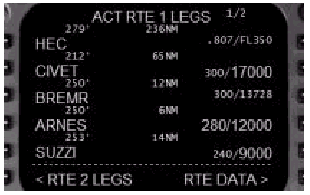
Consider the following example of how a VNAV
descent path is calculated with waypoint
constraints.
Airspeed and altitude descent constraints
are entered onto the LEGS page in the right
column of the waypoint data line.
Data displayed in small type are speed and
altitude predictions based on performance.
Data displayed in large type are speed and
altitude constraints.
The constraints are entered manually or by
procedure.
The example LEGS page shows an altitude constraint
of 17000 feet at CIVET.
The T/D point and VNAV idle descent path
are calculated based on this first waypoint
constraint.
Since a speed has not been specified at CIVET,
the FMC target airspeed from the VNAV DES
page is shown as 300 in small type.
After passing CIVET, the VNAV DES page changes
to "AT ARNES" and "12000"
since ARNES contains the next descent constraint
of 280/12000.
A VNAV path is calculated for a straight
descent between CIVET (at 17000 feet) and
ARNES (at 12000 feet), such that ARNES is
crossed at 280 knots.
Since no constraint has been entered for
BREMR, the data displayed is prediction data
based on the calculated VNAV path between
CIVET and ARNES.
After passing ARNES, the VNAV DES page changes
to "AT SUZZI" and "9000.
A VNAV path is calculated for a straight
descent between ARNES (at 12000) and SUZZI
(at 9000).
The SPEED TRANS of 240/10000 comes into play
between these two waypoints since the FMC
is predicting an airspeed of 240 at SUZZI.
Keep in mind that for a VNAV DES to continue
at each waypoint, the MCP ALT must be set
to a lower altitude than that listed for
a LEGS page constraint.
If the MCP ALT is reached prior to a LEGS
page constraint, the AFDS levels off in ALT
HOLD mode.
In this case, the MCP must be reset to a
lower altitude and VNAV reselected on the
MCP for a VNAV descent to continue.
6- Descend Now Prompt: This prompt displays before the T/D is reached.
When pressed, begins a descent of 1250 fpm
until reaching the calculated VNAV path.
For the descent to commence, the AFDS MCP
altitude must be set to a lower value.
The AFDS levels off at the higher of the
MCP altitude or the next FMC waypoint constraint.
7- Descend Direct Prompt: This prompt displays after the T/D is reached.
When pressed, deletes all waypoint altitude
constraints on the LEGS page between the
current aircraft altitude and the MCP altitude.
FMC儖乕僩僨乕僞偺曐懚 (RTE(儖乕僩), SID,
STAR, APP)
LEGS儁乕僕偵儕僗僩偝傟偰偄傞僂僄僀億僀儞僩偼丄FMC僨乕僞儀乕僗偵曐懚偝傟偰偄傑偡丅
僂僄僀億僀儞僩偼丄屻偱儖乕僩偲偟偰巊傢傟傞偨傔偵曐懚偝傟偰偄偨傝丄偁傞偄偼DEP/ARR僨乕僞儀乕僗僾儘僔乕僕儍(SID,
STAR, 傕偟偔偼 傾僾儘乕僠)偺堦晹偲偟偰曐懚偝傟偰偄傑偡丅
MENU僼傽儞僋僔儑儞僉乕傪墴偡偲丄5R LSK偺応強偵"SAVE
ROUTE>"僾儘儞僾僩偑儊僯儏乕偵昞帵偝傟傑偡丅

5R LSK傪墴偡偲丄SAVE ROUTE儊僯儏乕偑昞帵偝傟傑偡丅
SAVE ROUTE儊僯儏乕偵偼丄LEGS儁乕僕偺僨乕僞傪偳偺傛偆偵曐懚偡傞偐傪暘椶偡傞偨傔偺慖戰巿傪昞帵偡傞丄2偮偺儁乕僕偑偁傝傑偡丅
儁乕僕傪愗傝懼偊傞偨傔偵偼丄NEXT傗PREV PAGE僼傽儞僋僔儑儞僉乕傪巊偄傑偡丅
桳岠側LEGS儁乕僕偺僂僄僀億僀儞僩偼丄SID丄STAR傗傾僾儘乕僠偺僾儘儞僾僩傪巊偆偙偲偱曐懚偝傟傑偡丅
桳岠偱側偄儖乕僩儁乕僕偺僂僃僀億僀儞僩偼丄SID丄STAR傗傾僾儘乕僠偺僾儘儞僾僩傪巊偆偙偲偼偱偒傑偣傫丅

1- 儖乕僩1偺曐懚丂丗 RTE1偐傜RTE儁乕僕偺僨乕僞傗僂僃僀億僀儞僩傪僼儔僀僩僾儔儞偲偟偰曐懚偡傞偨傔偵偼丄1L
LSK傪墴偟傑偡丅
LSK偑墴偝傟傞偲丄僼儔僀僩僾儔儞柤傪擖椡偡傞偨傔5L
LSK偵僨乕僞儔僀儞偑昞帵偝傟傑偡丅

僼儔僀僩僾儔儞偺柤慜傪僗僋儔僢僠僷僢僪偵擖椡偟丄5L
LSK傪墴偟傑偡丅
僼儔僀僩僾儔儞柤偼丄嵟戝10暥帤傑偱偺傾儖僼傽儀僢僩傗悢帤偺擟堄偺慻傒崌傢偣偱擖椡偱偒傑偡丅
10暥帤埲忋傪擖椡偡傞偲丄僗僋儔僢僠僷僢僪偵"INVALID
ENTRY"儊僢僙乕僕偑昞帵偝傟傑偡丅
擖椡屻丄僼儔僀僩僾儔儞傪曐懚偡傞偨傔偵6L
LSK偺"<SAVE TO DISK"僾儘儞僾僩傪墴偟傑偡丅
曐懚偟偨僼儔僀僩僾儔儞傪嵞撉傒崬傒偡傞偨傔偵偼丄RTE儁乕僕偵偁傞CO
ROUTE僨乕僞僼傿乕儖僪偵僼儔僀僩僾儔儞柤傪擖椡偟傑偡丅
偙偺摦嶌偵傛傝帺摦揑偵丄偡傋偰偺儖乕僩忣曬傗僂僃僀億僀儞僩偑撉傒崬傑傟傑偡丅
2- 儖乕僩2偺曐懚丂丗RTE2偐傜RTE儁乕僕偺僨乕僞傗僂僃僀億僀儞僩傪僼儔僀僩僾儔儞偲偟偰曐懚偡傞偨傔偵偼丄2L
LSK傪墴偟傑偡丅
僾儘僔乕僕儍偺寛掕偼丄忋偺RTE1偱婰弎偟偨傕偺偲摨偠偱偡丅
3- LEGS傪SID偲偟偰曐懚丂丗 傾僋僥傿僽側LEGS儁乕僕偵儕僗僩偝傟偰偄傞僂僃僀億僀儞僩傪丄RTE儁乕僕偵昞帵偝傟偰偄傞弌敪嬻峘偺SID僾儘僔乕僕儍偲偟偰曐懚偡傞偨傔偵偼丄3L
LSK傪墴偟傑偡丅
LSK偑墴偝傟傞偲丄SID傪揔梡偡傞偨傔偺弌敪嬻峘偺妸憱楬傪慖戰偡傞僒僽儊僯儏乕偑昞帵偝傟傑偡丅
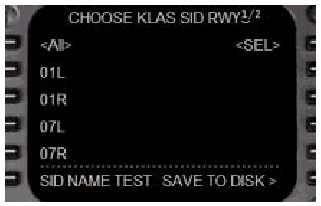
傕偟丄曐懚偝傟偨僂僃僀億僀儞僩偑慡偰偺妸憱楬偵妱摉傜傟傞SID偱偁傟偽丄"<ALL>"偑僨僼僅儖僩偺慖戰偱偁傞偨傔壗偺憖嶌傕偄傝傑偣傫丅
傕偟丄SID偺僂僃僀億僀儞僩偑1偮偺摿掕妸憱楬偵妱傝摉偰傜傟傞傕偺偱偁傟偽丄婓朷偡傞妸憱楬墶偺嵍懁偺LSK傪墴偟偰偔偩偝偄丅
僗僋儔僢僠僷僢僪偵SID偺婓朷偡傞柤徧傪擖椡偟丄6L
LSK傪墴偟傑偡丅
柤徧偼丄嵟戝10暥帤傑偱偺傾儖僼傽儀僢僩傗悢帤偺慻傒崌傢偣偱擖椡偱偒傑偡丅
SID傪曐懚偡傞偨傔6R LSK偺"SAVE TO DISK>"僾儘儞僾僩傪墴偟傑偡丅
4- LEGS傪STAR偁傞偄偼傾僾儘乕僠偲偟偰曐懚丂丗 傾僋僥傿僽側LEGS儁乕僕偵儕僗僩偝傟偰偄傞僂僃僀億僀儞僩傪丄RTE儁乕僕偵昞帵偝傟偰偄傞摓拝嬻峘偺STAR偁傞偄偼傾僾儘乕僠僾儘僔乕僕儍偲偟偰曐懚偡傞偨傔偵偼丄4L
LSK傪墴偟傑偡丅
4L LSK傪墴偟丄摓拝妸憱楬偑傾僋僥傿僽側儖乕僩偵娷傑傟偰偄側偄応崌丄僂僃僀億僀儞僩偼STAR偲偟偰曐懚偝傟傑偡丅
師偺僨乕僞儔僀儞偑丄5L LSK偵昞帵偝傟傑偡丂丗

僗僋儔僢僠僷僢僪偵STAR偺柤慜傪擖椡偟丄5L
LSK傪墴偟傑偡丅
STAR柤偼丄嵟戝10暥帤傑偱偺傾儖僼傽儀僢僩傗悢帤偺慻傒崌傢偣偱擖椡偱偒傑偡丅
STAR傪曐懚偡傞偨傔丄6L LSK偺"<SAVE
TO DISK"僾儘儞僾僩傪墴偟偰偔偩偝偄丅
4L LSK傪墴偟丄摓拝妸憱楬偑桳岠側儖乕僩偺僂僃僀億僀儞僩偲偟偰昞帵偝傟傞偲偒丄僂僃僀億僀儞僩偼傾僾儘乕僠偲偟偰曐懚偝傟傑偡丅
師偺傛偆側僨乕僞儔僀儞偑丄5L LSK偵昞帵偝傟傑偡丂丗

僗僋儔僢僠僷僢僪偵傾僾儘乕僠偺柤慜傪擖椡偟丄5L
LSK傪墴偟傑偡丅
傾僾儘乕僠柤偼丄嵟戝10暥帤傑偱偺傾儖僼傽儀僢僩傗悢帤偺慻傒崌傢偣偱擖椡偱偒傑偡丅
傾僾儘乕僠傪曐懚偡傞偨傔偵丄6L LSK偺"<SAVE
TO DISK"僾儘儞僾僩傪墴偟傑偡丅
5- SID僩儔儞僕僔儑儞偺曐懚丂丗 桳岠側LEGS儁乕僕偵儕僗僩偝傟偰偄傞僂僃僀億僀儞僩傪SID僩儔儞僕僔儑儞偲偟偰曐懚偡傞偨傔偵偼丄1L
LSK傪墴偟傑偡丅
LSK偑墴偝傟傞偲丄弌敪嬻峘偺棙梡壜擻側SID偺僒僽儊僯儏乕偑昞帵偝傟傑偡丅
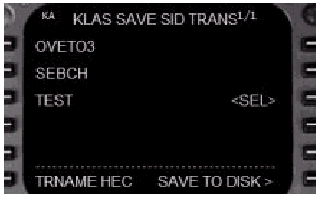
偙偺椺偱偼丄婛偵僾儘僌儔儉偝傟偰偄傞SID偑3偮昞帵偝傟偰偄傑偡丅
SID柤們tLSK傪墴偟丄僩儔儞僕僔儑儞傪揔梡偡傞SID傪慖戰偟偰偔偩偝偄丅
僗僋儔僢僠僷僢僪偵SID僩儔儞僕僔儑儞偺柤慜傪擖椡偟丄6L
LSK傪墴偟傑偡丅
僩儔儞僕僔儑儞柤偼丄嵟戝10暥帤傑偱偺傾儖僼傽儀僢僩傗悢帤偺慻傒崌傢偣偱擖椡偱偒傑偡丅
慖戰偟偨SID偺SID僩儔儞僕僔儑儞傪曐懚偡傞偨傔丄6R
LSK偺"SAVE TO DISK>"僾儘儞僾僩傪墴偟傑偡丅
6- STAR僩儔儞僕僔儑儞偺曐懚丂丗 桳岠側LEGS儁乕僕偵儕僗僩偝傟偰偄傞僂僃僀億僀儞僩傪STAR僩儔儞僕僔儑儞偲偟偰曐懚偡傞偨傔偵偼丄2L
LSK傪墴偟傑偡丅
LSK偑墴偝傟傞偲丄摓拝嬻峘偺棙梡壜擻側STAR偺僒僽儊僯儏乕偑昞帵偝傟傑偡丅

偙偺椺偱偼丄婛偵僾儘僌儔儉偝傟偰偄傞STAR偑1偮昞帵偝傟偰偄傑偡丅
STAR柤們tLSK傪墴偟丄僩儔儞僕僔儑儞傪揔梡偡傞STAR傪慖戰偟偰偔偩偝偄丅
僗僋儔僢僠僷僢僪偵STAR僩儔儞僕僔儑儞偺柤慜傪擖椡偟丄6L
LSK傪墴偟傑偡丅
僩儔儞僕僔儑儞柤偼丄嵟戝10暥帤傑偱偺傾儖僼傽儀僢僩傗悢帤偺慻傒崌傢偣偱擖椡偱偒傑偡丅
慖戰偟偨STAR偺STAR僩儔儞僕僔儑儞傪曐懚偡傞偨傔丄6L
LSK偺"SAVE TO DISK>"僾儘儞僾僩傪墴偟傑偡丅
7- 傾僾儘乕僠僩儔儞僕僔儑儞偺曐懚丂丗 桳岠側LEGS儁乕僕偵昞帵偝傟偰偄傞僂僃僀億僀儞僩傪傾僾儘乕僠僩儔儞僕僔儑儞偲偟偰曐懚偡傞偨傔偵偼丄3L
LSK傪墴偟傑偡丅
LSK偑墴偝傟傞偲丄摓拝嬻峘偺棙梡壜擻側傾僾儘乕僠偺僒僽儊僯儏乕偑昞帵偝傟傑偡丅
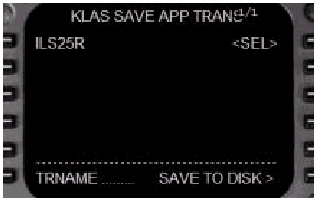
偙偺椺偱偼丄婛偵僾儘僌儔儉偝傟偰偄傞傾僾儘乕僠偑1偮昞帵偝傟偰偄傑偡丅
傾僾儘乕僠柤們tLSK傪墴偟丄僩儔儞僕僔儑儞傪揔梡偡傞傾僾儘乕僠傪慖戰偟偰偔偩偝偄丅
僗僋儔僢僠僷僢僪偵傾僾儘乕僠僩儔儞僕僔儑儞偺柤慜傪擖椡偟丄6L
LSK傪墴偟傑偡丅
僩儔儞僕僔儑儞柤偼丄嵟戝10暥帤傑偱偺傾儖僼傽儀僢僩傗悢帤偺慻傒崌傢偣偱擖椡偱偒傑偡丅
慖戰偟偨傾僾儘乕僠偺傾僾儘乕僠僩儔儞僕僔儑儞傪曐懚偡傞偨傔丄6L
LSK偺"SAVE TO DISK>"僾儘儞僾僩傪墴偟傑偡丅
8- 妸憱楬摿掕偺SID儗僌偺曐懚丂丗 偄偔偮偐偺SID偵偼丄儊僀儞SID僂僃僀億僀儞僩傛傝慜偵丄妸憱楬摿掕偺僩儔儞僕僔儑儞僂僃僀億僀儞僩傪傕偮応崌偑偁傝傑偡丅
偙偺僾儘儞僾僩偼丄暋悢偺妸憱楬僩儔儞僕僔儑儞傪傕偮SID梡偵丄妸憱楬摿掕僂僃僀億僀儞僩傪曐懚偡傞偨傔偵巊傢傟傑偡丅
妸憱楬摿掕僂僃僀億僀儞僩傪揔梡偡傞妸憱楬偺柤慜傪丄RTE儁乕僕偵偍偄偰擖椡偟側偗傟偽側傝傑偣傫丅
堦搙丄妸憱楬摿掕僩儔儞僕僔儑儞僂僃僀億僀儞僩傪傾僋僥傿僽側LEGS儁乕僕偵擖椡偟丄SID柤傪慖戰偡傞僒僽儊僯儏乕傪昞帵偡傞偨傔丄4L
LSK傪墴偟傑偡丅(愭偺#5偱帵偝傟偨庤弴)
僩儔儞僕僔儑儞傪揔梡偡傞SID傪慖戰偡傞偨傔丄揔梡偡傞SID們tLSK傪墴偟偰偔偩偝偄丅
慖戰偟偨SID偺偨傔偺妸憱楬僩儔儞僕僔儑儞傪曐懚偡傞偨傔丄6R
LSK偺"SAVE TO DISK>"僾儘儞僾僩傪墴偟傑偡丅
| 亙亙TOP儁乕僕 | 亙Level-D 767 儊僯儏乕 | 亙儅僯儏傾儖栚師 | 亙慜偺儁乕僕 | 亜師偺儁乕僕傊 |